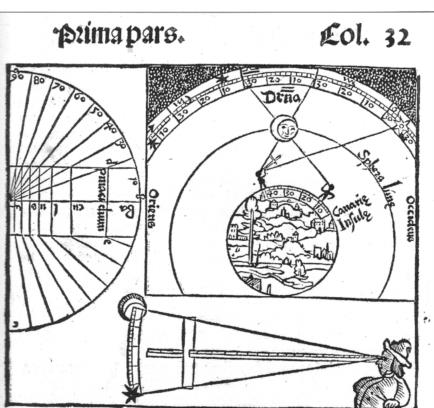
NavList:
A Community Devoted to the Preservation and Practice of Celestial Navigation and Other Methods of Traditional Wayfinding
Re: Cross Staff in use, 1574 image
From: George Huxtable
Date: 2009 Oct 18, 11:03 +0100
From: George Huxtable
Date: 2009 Oct 18, 11:03 +0100
Wolfgang and Nicolas have provided authoritative answers to some of Brad's questions about the cross-staff, but there's a bit more to add. Brad wrote- "From the recommendations of "A Regiment for the Sea", Bourne; the mariner was advised to align the upper limb of the sun with the upper edge of the cross staff, but only when above 60 degrees. Below 60 degrees, and the mariner is informed to align the center of the sun with the upper edge." Not the way I read his tract. Though that text may run without paragraph separations, there are section-headings in the margins. The previous section had been headed ""The astrolobe is best to take the heigth of the Sunne at .60. 70. or .80 degrees in heigth". But then he goes on to discuss what to do when your staff is not provided with dark glasses, marginal note "How to preserve your eyes when you touch the Sunne with your crosse staffe and have no glasses. The diameter of the Sunne is 30. or .31. minuts". No longer, there, is he referring to the 60-degrees-and-over situation, as I read it. He is providing a general rule for observing the Sun at any altitude, if you have no dark glass at the tip of the transom. He recommends that then you should protect your eyes by covering the complete Sun disc with the top of the transom, and subtract 15 minutes from the result. Not much chance of doing that in a rolling vessel! However, I don't see any great instrumental difficulty about the procedure, using a dark glass, of putting the Sun's mid-point at the tip of the transom, by eye estimation. To my mind, anyone should be able to bisect the Sun disc, by eye, to put its centre within a couple of minutes of the truth; an error that's small in comparison with the imprecision of a any cross-staff. ================================ Brad and Wolfgang referred to the illustration Brad gave from Apian, at http://www.fer3.com/arc/imgx/COSMOGRAPHIA-PETRI-APIANI-1574.doc Unfortunately, the top of that picture was cut off, but as it's rather interesting. I attach a complete, slightly-different engraving from another edition. The picture on the left shows the geometrical construction required to divide the stick of a cross-staff. The bottom picture shows a portly observer measuring a lunar distance. He is aligning the centre of the Moon with the end of the transom; more difficult to estimate than for the Sun, especially with a crescent Moon. But look at the top picture, which Wolfgang points out is intended to show parallax. Or is it? It shows two observers, 30 degrees apart on the Earth's surface, seeing the Moon at two different positions in the sky, against the star background, that are also 30 degrees apart! But that's not how parallax works: if it was, lunar distance navigation would be simple. Moon parallax can never be more than a degree-or-so. It's only because the distances of Moon and sky are so grotesquely distorted that the engraving has come out as it has. Such a picture would mislead any reader's understanding, and indeed raises the question as to whether the designer of the engraving, or the author of the text, really understood the nature of parallax. Of course, at that date Moon and star distances were not precisely known, but even Ptolemy and Hipparchus knew much better than that, as did Kepler. =================== Anyway, the whole notion of lunar distance measurement of longitude was then nonsense, for two reasons. First, the precision of a cross-staff was nowhere near good enough for a lunar. Second, the predictions of the Moon's motion were nowhere near good enough either. It was an interesting idea, that could not be fulfilled until two centuries later. But no question about it, the cross-staff (or Jacob's staff, ot Balestilla) was a worthwhile and useful instrument for measuring latitude, widely used by mariners over several centuries. George. contact George Huxtable, at george@hux.me.uk or at +44 1865 820222 (from UK, 01865 820222) or at 1 Sandy Lane, Southmoor, Abingdon, Oxon OX13 5HX, UK. --~--~---------~--~----~------------~-------~--~----~ NavList message boards: www.fer3.com/arc Or post by email to: NavList@fer3.com To , email NavList+@fer3.com -~----------~----~----~----~------~----~------~--~---







